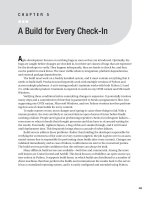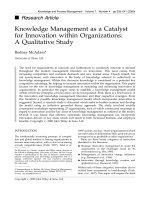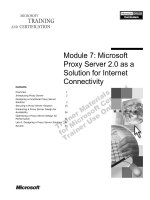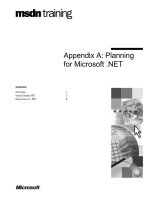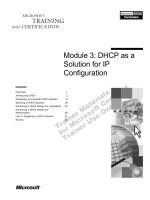A Build for Every Check-In
Bạn đang xem bản rút gọn của tài liệu. Xem và tải ngay bản đầy đủ của tài liệu tại đây (894.3 KB, 36 trang )
A Build for Every Check-In
A
gile development focuses on catching bugs as soon as they are introduced. Optimally, the
bugs are caught before changes are checked in, but there are classes of bugs that are expensive
for the developer to verify. They happen infrequently, they are hassle to check for, and they
can be painful to track down. The most visible relate to integration, platform dependencies,
and external package dependencies.
The build must work on a freshly installed system, and it must contain everything that it
needs to build itself. Products must frequently work with multiple versions of Python and
across multiple platforms. A unit-testing module I maintain works with both Python 2.4 and
2.5, while another product I maintain is expected to work on any UNIX variant and Microsoft
Windows.
Verifying these conditions before committing changes is expensive. It potentially involves
many steps and a commitment of time that is guaranteed to break a programmer’s flow. Just
supporting one UNIX variant, Microsoft Windows, and two Python versions involves perform-
ing four sets of clean builds for every commit.
To make matters worse, most changes aren’t going to cause these things to fail. With a
mature product, the tests are likely to succeed dozens upon dozens of times before finally
catching a failure. People aren’t good at performing repetitive checks for infrequent failures—
even more so when it derails their thought processes and they have to sit around waiting for
the results. Eventually, vigilance lapses, a bug of this sort sneaks through, and it isn’t found
until deployment time. This frequently brings about a cascade of other failures.
Build servers address these problems. Rather than holding the developer responsible for
verifying the correctness of the code on every system targeted, the job is given over to an auto-
mated system that is r
esponsible for per
for
ming clean builds after every commit. Changes are
validated immediately, and in case of failure, notifications are sent to the concerned parties.
The build servers provide confidence that the software can always be built.
M
any different build servers are available—both free and commercial. Among the more
well known are CruiseControl and Anthill. This book focuses on Buildbot, an open source sys-
tem written in Python. It supports build farms, in which builds are distributed to a number of
client machines that then per
form the builds and communicate the results back to the server.
It has a centralized reporting system, and it is easily configured and extended using Python.
103
CHAPTER 5
9810ch05.qxd 5/20/08 4:51 PM Page 103
Buildbot Architecture
B
uildbot is a common open build system. It is written in Python, but it will build anything.
It uses a master-and-slave architecture. The central build master controls one or more build
slaves. Builds are triggered by the master, and performed on the slaves. The slaves can be of a
d
ifferent architecture than the master. The slaves report build results to the master, and the
master reports them to the users. The master contains a minimal web server showing the real-
time build telemetry.
There are multiple options for triggering builds. The master can do it periodically, pro-
ducing a nightly or hourly build. More interestingly, the master can be triggered to perform
builds whenever new changes are committed.
The system demonstrated in this chapter contains a master, a slave, and a remote Subver-
sion repository. The three systems are named
buildmaster, slave-lnx01, and source. On my
systems, these are DNS aliases for the underlying hosts. The slave performs builds against
both Python 2.4 and 2.5., and these builds are triggered automatically after each commit.
Dedicated users will be created to run both Buildbot and Subversion. On the build sys-
tems, the application Buildbot will be run as the user
build; and on the source server,
Subversion will be run as the user
svn.
ALIASING HOSTS
On my network, the names buildmaster, slave-lnx01, and source are aliases for the two hosts
phytoplankton and agile. buildmaster and source are aliases for phytoplankton, and
slave-lnx01 is an alias for agile. The names refer to the service being provided, not the underlying host.
This way, the service can be moved to another host without disrupting clients (both human and machine).
I might do this if I wanted to move
agile to a real box rather than running it under a VM, as I currently
do. I might also do this if
phytoplankton died, or if the load of running the repository became too much for
this one system to bear.
Installing Buildbot
Buildbot itself is a Setuptools package. It can be downloaded and installed using easy_install,
but it is built on top of Twisted, which is “an event-driven networking engine.” Twisted pro-
vides the bulk of the networking infrastructure for Buildbot. It’s best to install Twisted before
installing Buildbot.
Twisted is built with Distutils, and it must be installed carefully in multiple steps. It has its
own dependency on a package called Zope Interface, which provides a limited typing system
for Python. You could spend time chasing this package down, but that’s not necessary, as it’s
bundled with Twisted. However, although it is bundled, it must be installed manually before
Twisted.
I’ll start by demonstrating how to install Buildbot on buildmaster. You’ll be installing spe-
cial Python installations just for the build slave’s use, so it doesn’t matter much where Buildbot
and its dependencies are installed. I’m going to use the primary system installation:
CHAPTER 5
■
A BUILD FOR EVERY CHECK-IN104
9810ch05.qxd 5/20/08 4:51 PM Page 104
$ curl -L -o Twisted-2.5.0.tar.bz2
➥
/>%
Total % Received % Xferd Average Speed Time Time Time Current
Dload Upload Total Spent Left Speed
100 2683k 100 2683k 0 0 741k 0 0:00:03 0:00:03 --:--:-- 787k
$ bunzip2 Twisted-2.5.0.tar.bz2
$ tar xvf Twisted-2.5.0.tar
Twisted-2.5.0/
Twisted-2.5.0/TwistedConch-0.8.0/
...
Twisted-2.5.0/LICENSE
Twisted-2.5.0/setup.py
$ cd Twisted-2.5.0
$ ls -F
LICENSE TwistedMail-0.4.0/ TwistedWords-0.5.0/
README TwistedNames-0.4.0/ setup.py*
TwistedConch-0.8.0/ TwistedNews-0.3.0/ zope.interface-3.3.0/
TwistedCore-2.5.0/ TwistedRunner-0.2.0/
TwistedLore-0.3.0/ TwistedWeb-0.7.0/
$ cd zope.interface-3.3.0
$ sudo python ./setup.py install
running install
running bdist_egg
...
Processing dependencies for zope.interface==3.3.0
Finished processing dependencies for zope.interface==3.3.0
■
Warning
With most packages, running
install
correctly invokes
build
, but that has not been my
experience with Twisted. It is necessary to run build and install separately.
$ cd ..
$ python ./setup.py install
CHAPTER 5
■
A BUILD FOR EVERY CHECK-IN 105
9810ch05.qxd 5/20/08 4:51 PM Page 105
running install
running build
...
byte-compiling /usr/lib/python2.5/site-packages/twisted/
➥
news/test/test_nntp.py to test_nntp.pyc
byte-compiling /usr/lib/python2.5/site-packages/twisted/
➥
plugins/twisted_news.py to twisted_news.pyc
At this point, Twisted is installed, and Buildbot can now be installed. Buildbot is installed
with
easy_install, which is part of Setuptools. If it hasn’t been installed yet, then you’ll need
to do this first. See Chapter 4 for more information.
There is one catch, though. Buildbot has contributed programs that are shipped with it,
but that are not installed by easy_install. You’ll use one later, so you’ll want the source pack-
age to remain on the system. The build directory option
-b specifies a directory where the
installation is staged from. When
easy_install completes, this directory will be left behind
and the component files will be accessible.
$ easy_install -b /tmp/bbinst buildbot
Searching for buildbot
Reading />...
Installed /Users/jeff/Library/Python/2.5/site-packages/
➥
buildbot-0.7.6-py2.5.egg
Processing dependencies for buildbot
Finished processing dependencies for buildbot
$ buildbot --version
Buildbot version: 0.7.6
Twisted version: 2.5.0
The identical process must now be performed on all machines communicating with
Buildbot. This includes the Subversion host, too. Once the installations are complete, the
master and slave can then be configured.
Configuring the Build System
As outlined earlier
, ther
e
ar
e two build hosts in our system: the Buildbot master, named
buildmaster, and the Buildbot slave, named slave-lnx01. Buildbot runs on both systems as a
dedicated user
, which you’ll name
build.
This provides administrative and security benefits.
S
tar
tup configur
ation can be kept within the user
’
s account. The user
build has limited r
ights
,
so any compromises of the Buildbot server will be limited to
build’s account, and any miscon-
figur
ations will be limited by filesystem permissions.
CHAPTER 5
■
A BUILD FOR EVERY CHECK-IN106
9810ch05.qxd 5/20/08 4:51 PM Page 106
When a Buildbot slave starts, it contacts the build master. It needs three pieces of infor-
m
ation to do this. First, it needs the name of the build master so that it can find it on the
network. The port identifies the Buildbot instance running on the build master, and the pass-
word authenticates the slave to the master. The master must know which port to listen on, and
it must know the password that slaves will present.
In the environment discussed here, the build master runs on the host
buildmaster listen-
ing on port
4484 for the password Fo74gh18 from instance rsreader-full-py2.5. The build
server instances run from within the directory
/usr/local/buildbot. RSReader is the project
started in Chapter 4. The master lives in
/usr/local/buildbot/master/rsreader, and the slave
lives in
/usr/local/buildbot/slave/rsreader. This directory structure allows you to intermix
independent Buildbot instances for different projects on the same machines.
Setting up communications between the master and the slave is the first goal. Retrieving
source code or performing a build is pointless until the two servers can speak to each other.
Mastering Buildbot
The build master is configured before the slave, as the slave’s status is determined through its
interactions with the build master. Creating the
build user and the directories are the first
steps.
■
Tip
If you’re trying to install Buildbot on Windows systems, it is started with
buildbot.bat
. This script is
installed into
\Python25\scripts
. Unfortunately, it has a hard-coded reference to a nonexistent script in
\Python23
. This reference will need to be changed by hand.
$ useradd buid
$ sudo mkdir -p /usr/local/buildbot/master/rsreader
$ sudo chown build:build /usr/local/buildbot/master/rsreader
The next steps ar
e performed as the newly created user
build.
They create the basic
configuration files for a master.
$ su - build
$ buildbot create-master /usr/local/buildbot/master/rsreader
updating existing installation
chdir /usr/local/buildbot/master/rsreader
creating master.cfg.sample
populating public_html/
creating Makefile.sample
buildmaster configured in /usr/local/buildbot/master/rsreader
$ ls -F /usr/local/buildbot/master/rsreader
CHAPTER 5
■
A BUILD FOR EVERY CHECK-IN 107
9810ch05.qxd 5/20/08 4:51 PM Page 107
Makefile.sample buildbot.tac
master.cfg.sample public_html/
Once upon a time (Buildbot 0.6.5 and earlier), makefiles were used to start and stop
Buildbot. This mechanism has been superseded by the
buildbot command in current ver-
sions. Makefiles can still be used to override the startup process, but that’s voodoo that I won’t
address, so you can safely forget that
Makefile.sample exists.
Buildbot.tac is only of marginally more interest. It is used by the buildbot command to
start the server. Essentially, it defines if this server is a client or a slave. It is necessary to Build-
bot’s operation, but you should never have to touch it.
The public_html directory is the document root for the build master’s internal web server.
It supplies the static content that will be served to your browser. Customizations to Buildbot’s
appearance go here, but they are strictly optional.
Of far more interest is master.cfg.sample. It is the template for the file master.cfg, which
defines most of the master’s behavior. It is a Python source file defining a single dictionary
named
BuildmasterConfig. This dictionary describes almost everything about the build mas-
ter and the build process that ever needs changing. Much of this chapter is devoted to writing
this file.
You’ll start off with a minimal
master.cfg. It defines the BuildmasterConfig dictionary and
aliases it to the variable
c. This is done to improve readability and save keystrokes (although
rumors of an impending keystroke shortage have been determined to be false by reputable
authorities).
# This is the dictionary that the buildmaster pays attention
# to. We also use a shorter alias to save typing.
c = BuildmasterConfig = {}
Next is the slaves property, which defines a list of BuildSlave objects. Each of these con-
tains the name of a slave and the password that will be used to secure that connection. All
slaves talk to the master on a single port, and the name is necessary to distinguish them from
one another. Every slave has its own password, too. A separate password allows slaves to be
controlled by different individuals without compromising the security of other slaves. In our
case, we have one slave named
rsreader-linux, and its password is Fo74gh18
.
####### BUILDSLAVES
from buildbot.buildslave import BuildSlave
c['slaves'] = [BuildSlave("slave-lnx01", "Fo74gh18")]
The master listens for connections over a single port. The slavePortnum property defines
this. This number is arbitrary, but it should be above 1024, as lower port numbers are reserved
as rendezvous locations for well-known services (like mail) and web traffic. In our configura-
tion, it will be 4484.
# 'slavePortnum' defines the TCP port to listen on. This must match the value
# configured into the buildslaves (with their --master option)
c['slavePortnum'] = 4484
CHAPTER 5
■
A BUILD FOR EVERY CHECK-IN108
9810ch05.qxd 5/20/08 4:51 PM Page 108
When the source code changes, a build will be triggered. The build master needs to know
h
ow to find changes. Various classes within
b
uildbot.changes
s
upply these behaviors. The
class
PBChangeSource implements a listener that sits on slavePortnum and waits for externally
generated change notifications. When it receives an appropriate notification, it triggers a
build. In a few sections, you’ll configure Subversion to send these notifications.
####### CHANGE SOURCES
from buildbot.changes.pb import PBChangeSource
c['change_source'] = PBChangeSource()
The schedulers property defines when builds are launched. It is a list of scheduler objects.
These tie a scheduling policy to a builder that actually performs the build. You’re going to
schedule one build for Python 2.5. The scheduler will work on any branch, and it will run
when there have been no more changes for 60 seconds.
####### SCHEDULERS
c['schedulers'] = []
c['schedulers'].append(Scheduler(name="rsreader",
branch=None,
treeStableTimer=60,
builderNames=["rsreader-full-py2.5"]))
Build factories describe the nitty-gritty details of building the application. They construct
the instructions run by slaves. I shall be spending a lot of time on build factories, but right now
a simple factory will suffice to test communication between the master and slave. The simple
builder factory
f1 prints the message build was run.
####### BUILDERS
from buildbot.process import factory
from buildbot.steps.shell import ShellCommand
f1 = factory.BuildFactory()
f1.addStep(ShellCommand(command="echo 'build was run'"))
The builders property contains a list of builders. A builder is a dictionary associating the
builder’s name, the slave it runs on, and a builder factory. It also names the build directory. In
this case
, the builder is named
buildbot-full-py2.5, and it r
uns on the slave
slave-lnx01 in
the directory
full-py2.5 using the builder factory f1. The build directory is relative to the
Buildbot root. In this case, the full path to the builder will be
/usr/local/buildbot/slave/
rsreader/full-py2.5
.
b1 = {'name': "rsreader-full-py2.5",
'slavename': "slave-lnx01",
'builddir': "full-py2.5",
'factory': f,
}
c['builders'] = [b1]
CHAPTER 5
■
A BUILD FOR EVERY CHECK-IN 109
9810ch05.qxd 5/20/08 4:51 PM Page 109
The status property controls how build results are reported. We are implementing two.
The
html.WebStatus class implements a page referred to as the waterfall display, which shows
the entire build system’s recent activity. The web server port is configured with the
http_port
keyword. Here it’s being configured to listen on port 8010.
The class
mail.MailNotifier sends e-mail when a build fails. It is inventive and persistent
in its actions. There are other notification classes, with the
words.IRC class being perhaps the
most interesting of those not being used in this example.
####### STATUS TARGETS
c['status'] = []
from buildbot.status.html import WebStatus
c['status'].append(WebStatus(http_port=8010))
from buildbot.status.mail import MailNotifier
c['status'].append(MailNotifier(
fromaddr="",
extraRecipients=[""],
sendToInterestedUsers=False))
The properties projectName, projectUrl, and buildbotUrl configure communications
with the user. The project name is used on the waterfall page. The project URL is the link from
the waterfall page to the project’s web site.
BuildbotURL is the base URL to reach the Buildbot
web server configured in the
status property. Buildbot can’t determine this URL on its own, so
it must be configured here.
####### PROJECT IDENTITY
c['projectName'] = "RSReader"
c['projectURL'] = " />c['buildbotURL'] = ":8010/"
At this point, you can start the build master:
$ buildbot start /usr/local/buildbot/master/rsreader
Following twistd.log until startup finished..
2008-05-12 11:21:47-0700 [-] Log opened.
…
2008-05-12 11:21:47-0700 [-] BuildMaster listening on port tcp:4484
2008-05-12 11:21:47-0700 [-] configuration update started
2008-05-12 11:21:47-0700 [-] configuration update complete
The buildmaster appears to have (re)started correctly.
The messages indicate that B
uildbot star
ted correctly. In previous versions, the startup
messages w
er
e untr
ustwor
thy and y
ou often had to search through the file
twistd.log in the
application dir
ector
y to deter
mine if the r
epor
ted status was accur
ate
.
This seems to hav
e
been r
emedied as of Buildbot 0.7.7. The landing screen is shown in Figure 5-1.
CHAPTER 5
■
A BUILD FOR EVERY CHECK-IN110
9810ch05.qxd 5/20/08 4:51 PM Page 110
Figure 5-1. The Buildbot landing page on the host buildmaster and port 8010
Clicking the first link title, Waterfall Display, takes you to the page shown in Figure 5-2,
which is a timeline. The top of the page represents now, and the screen extends down into the
past. Each column represents a builder and the activity taking place. The builder’s creation
and the master’s startup are both represented, so the display conveys information about the
system’s gross state, reducing the need to search through
twistd.log. The red box at the top
indicates that the build slave for
build-full-py2.5 is offline.
Figure 5-2. The Buildbot waterfall display
CHAPTER 5
■
A BUILD FOR EVERY CHECK-IN 111
9810ch05.qxd 5/20/08 4:51 PM Page 111
The properties projectName and projectUrl are used to produce the RSReader links at the
top and bottom of the waterfall display. Clicking on either one is sufficient to verify the correct
values. At this point, the basic server configuration is complete, and there is one last step.
The server must be started at reboot. Once upon a time, it was necessary to write a startup
script and insert it into
/etc/init.d on UNIX systems and create a few magically named sym-
bolic links in the
/etc/rc directories. These days, processes can be started from cron at reboot
by adding the following line to the
build user’s crontab with the command crontab -e:
@reboot /path/to/buildbot start /usr/local/buildbot/master/rsreader
This technique should work on most modern UNIX systems, as well as Mac OS X. Cron
doesn’t have access to your full shell environment, so it is important to use the full path to the
buildbot executable. Your shell may be able to locate buildbot when you are logged in, but it
may not be able to when run from cron’s extremely limited environment.
Enslaving Buildbot
In grand strokes, creating a basic Buildbot slave is similar to creating a master, but much sim-
pler in the initial details. If running on a separate system, as in this example, then Buildbot
must be installed first. Then the
build user and Buildbot directories are created, a slave
instance is created, the configuration files are updated, and Buildbot is started. In this test
environment, the slave runs on
slave-lnx01.
$ useradd build
$ sudo mkdir /usr/local/buildbot/slave/rsreader
$ sudo chown build:build /usr/local/buildbot/slave/rsreader
After creating the build directories, the client is configured from build’s account on
slave-lnx01. Four pieces of information are necessary. The slave contacts the Buildbot master
using the master’s host name and port. In this case, the host name is
buildmaster and the port
is 4484. The slave identifies itself with a unique name. (The host name is insufficient, as there
can be more than one slave running on a single host.) This is the name referred to on the
master in both the builder definition and the
slaves property. Finally, the slave needs the
password to secure the connection. The
BuildSlave object in master.cfg defines it; in this
case, it’s
Fo74gh18.
$ su - build
$ buildbot create-slave /usr/local/buildbot/slave/rsreader
➥
buildmaster:4484 rsreader-linux Fo74gh18
updating existing installation
chdir /usr/local/buildbot/slave/rsreader
creating Makefile.sample
mkdir /usr/local/buildbot/slave/rsreader/info
Creating info/admin, you need to edit it appropriately
Creating info/host, you need to edit it appropriately
Please edit the files in /usr/local/buildbot/slave/rsreader/info appropriately.
buildslave configured in /usr/local/buildbot/slave/rsreader
CHAPTER 5
■
A BUILD FOR EVERY CHECK-IN112
9810ch05.qxd 5/20/08 4:51 PM Page 112
$ cd /usr/local/buildbot/slave/rsreader
$ ls -F
buildbot.tac info/ Makefile.sample
$ ls -F info
admin host
Buildbot.tac
and Makefile.sample are analogous to those files on the build master.
Buildbot uses
Buildbot.tac to start the slave, but the slave’s configuration is also in this file.
Changes to the four configuration parameters can be made here. As with the master,
Makefile.sample is a vestigial file lingering from previous generations of Buildbot.
The files in the
info directory are of more interest. They are both text files containing
information that is sent to the build master.
info/admin contains this Buildbot administrator’s
name and e-mail address, while
info/host contains a description of the slave.
The default for
info/admin is Your Name Here <>. In my envi-
ronment, it is set to
Jeff Younker <>. The description in
slave-lnx01’s info/host file reads Produces pure Python 2.5 builds. info/host is just a text
file, and the information is to make your life, and the life of everyone who uses your build sys-
tem, a little bit brighter and clearer, so make the description concise and informative. With
these changes in place, the client can be started.
$ buildbot start /usr/local/buildbot/slave/rsreader
Following twistd.log until startup finished..
2007/11/27 02:18 -0700 [-] Log opened.
2007/11/27 02:18 -0700 [-] twistd 2.5.0 (/usr/bin/python 2.5.0) starting up
2007/11/27 02:18 -0700 [-] reactor class:
➥
<class 'twisted.internet.selectreactor.SelectReactor'>
2007/11/27 02:18 -0700 [-] Loading buildbot.tac...
2007/11/27 02:18 -0700 [-] Creating BuildSlave
2007/11/27 02:18 -0700 [-] Loaded.
2007/11/27 02:18 -0700 [-] Starting factory <buildbot.slave.bot.BotFactory
➥
instance at 0xa0e484c>
2007/11/27 02:18 -0700 [broker,client] message from master: attached
The buildslave appears to have (re)started correctly.
The build slave has started and connected to the build master, which you can see on the
water
fall display in Figure 5-3.
CHAPTER 5
■
A BUILD FOR EVERY CHECK-IN 113
9810ch05.qxd 5/20/08 4:51 PM Page 113
Figure 5-3. The slave has successfully connected with the master.
At this point, basic connectivity has been established and a build can be triggered with
the command
buildbot sendchange:
$ buildbot sendchange --master buildmaster:4484 -u jeff -n 30 setup.py
change sent successfully
The file name is arbitrary, but the change number specified with -n (in this case 30) is not.
The project branch (
rsreader/trunk in this case) must exist at this revision, or else the build
will fail.
The waterfall display immediately shows that the change has been received, and it shows
a countdown timer until the build starts. Any changes submitted in this window will reset the
timer. This is shown in Figure 5-4.
While the message is being, run the step is rendered in yellow. Once it completes, the step
is r
ender
ed in green. If the step had failed, it would be red, and if an exception had been
encounter
ed, it would be purple. O
nce the timer expires
, the build runs and the slave echoes
its message. The output, shown in Figure 5-5, links from the build step.
CHAPTER 5
■
A BUILD FOR EVERY CHECK-IN114
9810ch05.qxd 5/20/08 4:51 PM Page 114
Figure 5-4. The first build has been triggered.
Figure 5-5. The
echo step output
CHAPTER 5
■
A BUILD FOR EVERY CHECK-IN 115
9810ch05.qxd 5/20/08 4:51 PM Page 115
Information about the step is rendered in blue, and the actual output is rendered in black.
I
t’s clear that there is far more information about the step than actual output:
• The command run by the build step is shown in the first line.
• The present working directory follows. It indicates where the command runs from.
• The entire shell environment is displayed. Incorrect environment settings are a com-
mon source of build errors, so having this information recorded and available assists
with debugging build problems.
• The command’s output follows the environment. There’s only one line in this case.
• The command’s exit code is shown last. As with any UNIX shell command,
0 indicates
success.
Hooking Up Source Control
The build master and build slave are now on separate hosts. They both need access to the Sub-
version repository. Until now, Subversion has been accessed directly through the filesystem,
but this will no longer work. However, this isn’t a simple choice. Subversion can be accessed
remotely via a bewildering spectrum of methods. Repositories can be accessed through the
Subversion network server, through WebDAV and the Apache web server, or by tunneling over
a shell transport such as SSH. Enumerating the pros and cons of each approach would consti-
tute a chapter’s worth of material in itself.
I’m going to choose one pair of methods and stick with them, but if you’d like more infor-
mation, then I encourage you to consult
Practical Subversion, Second Edition, by Daniel Berlin
and Garrett Rooney (Apress, 2006). The good news is that if you choose another method, then
the changes on the client amount to nothing more than changing a URL.
For the rest of the book, I’m choosing a combination of
svnserve running as a daemon for
read-only access and
svnserve over SSH for write access. This is a common configuration in
which anyone can check out files anonymously, but committing changes requires a login and
therefore authentication.
Committers need accounts on the Subversion server and write access to the Subversion
repository. Authorization is done with group permissions. The repository tree is writable by
the Subversion group, and all committers are members of that group. In this book, that group
will be named svn.
Files created through
svnserve over SSH are owned by the committer, but they must be
writable by the Subversion group.
svnserve sets the appropriate permissions, but those are
affected b
y the user’s umask. The umask turns off selected permissions when files are written.
More frequently than not, the user’s default umask turns off group write permissions, and it is
therefore necessary to override it.
Y
ou do this with a wrapper script that replaces
svnserve.
The wrapper script sets the
umask to
002 (which turns off writing by others) and calls the original svnserve while passing
along all the arguments it received:
$ sudo mv /usr/local/bin/svnserve /usr/local/bin/svnserve-stock
$ sudo vi /usr/local/bin/svnserve
CHAPTER 5
■
A BUILD FOR EVERY CHECK-IN116
9810ch05.qxd 5/20/08 4:51 PM Page 116

